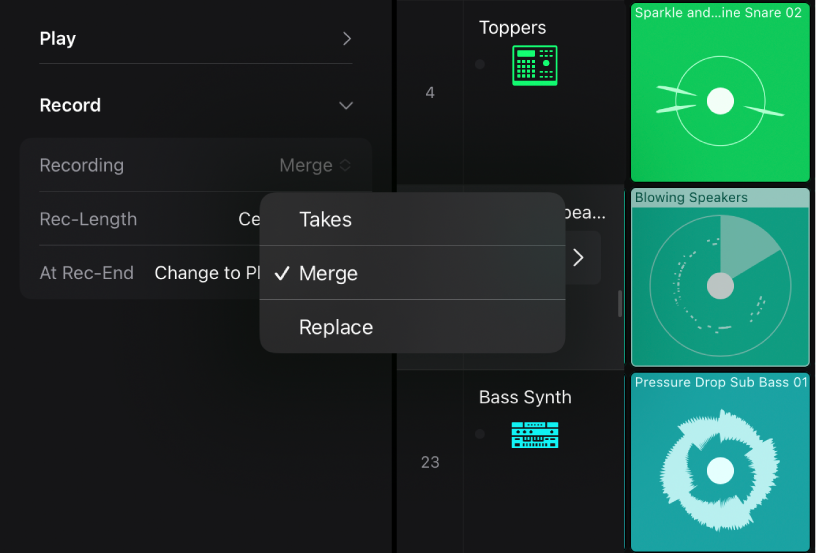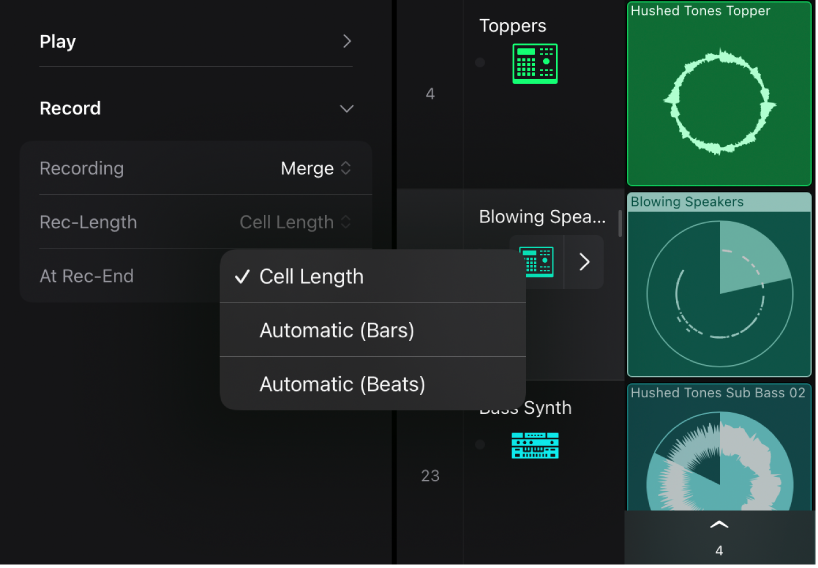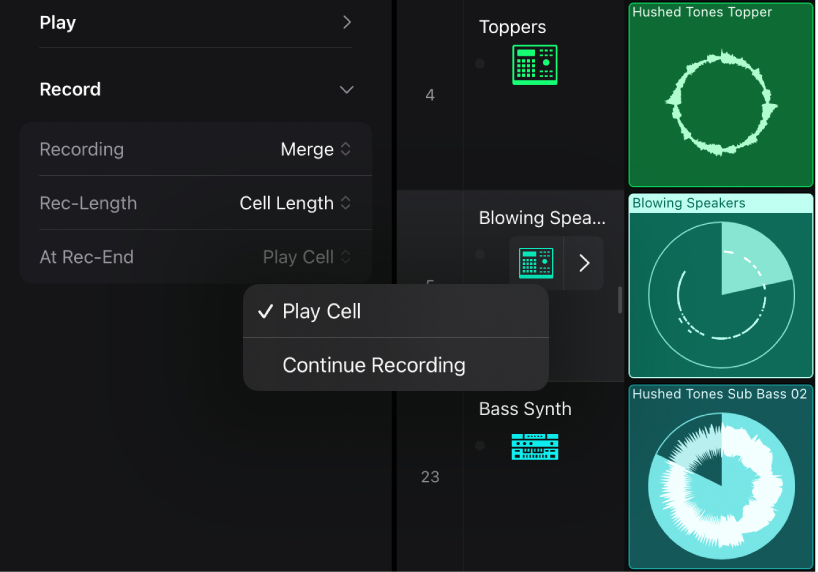Logic Pro User Guide for iPad
- What’s new in Logic Pro 1.1
-
- What is Logic Pro?
- Working areas
- Work with function buttons
- Work with numeric values
-
- Intro to tracks
- Create tracks
- Create tracks using drag and drop
- Choose the default region type for a software instrument track
- Select tracks
- Duplicate tracks
- Reorder tracks
- Rename tracks
- Change track icons
- Change track colors
- Use the tuner on an audio track
- Show the output track in the Tracks area
- Delete tracks
- Edit track parameters
- Start a Logic Pro subscription
- How to get help
-
- Intro to recording
-
- Before recording software instruments
- Record software instruments
- Record additional software instrument takes
- Record to multiple software instrument tracks
- Record multiple MIDI devices to multiple tracks
- Record software instruments and audio simultaneously
- Merge software instrument recordings
- Spot erase software instrument recordings
- Replace software instrument recordings
- Capture your most recent MIDI performance
- Use the metronome
- Use the count-in
-
- Intro to arranging
-
- Intro to regions
- Select regions
- Cut, copy, and paste regions
- Move regions
- Remove gaps between regions
- Delay region playback
- Trim regions
- Loop regions
- Repeat regions
- Mute regions
- Split and join regions
- Stretch regions
- Separate a MIDI region by note pitch
- Bounce regions in place
- Change the gain of audio regions
- Create regions in the Tracks area
- Convert a MIDI region to a Drummer region or a pattern region
- Rename regions
- Change the color of regions
- Delete regions
- Create fades on audio regions
- Access mixing functions using the Fader
-
- Intro to Step Sequencer
- Use Step Sequencer with Drum Machine Designer
- Record Step Sequencer patterns live
- Step record Step Sequencer patterns
- Load and save patterns
- Modify pattern playback
- Edit steps
- Edit rows
- Edit Step Sequencer pattern, row, and step settings in the inspector
- Customize Step Sequencer
-
- Effect plug-ins overview
-
- Instrument plug-ins overview
-
- ES2 overview
- Interface overview
-
- Modulation overview
-
- Vector Envelope overview
- Use Vector Envelope points
- Use Vector Envelope solo and sustain points
- Set Vector Envelope segment times
- Vector Envelope XY pad controls
- Vector Envelope Actions menu
- Vector Envelope loop controls
- Vector Envelope release phase behavior
- Vector Envelope point transition shapes
- Use Vector Envelope time scaling
- Use the Mod Pad
- Modulation source reference
- Via modulation source reference
-
- Sample Alchemy overview
- Interface overview
- Add source material
- Save a preset
- Edit mode
- Play modes
- Source overview
- Synthesis modes
- Granular controls
- Additive effects
- Additive effect controls
- Spectral effect
- Spectral effect controls
- Filter module
- Low and highpass filter
- Comb PM filter
- Downsampler filter
- FM filter
- Envelope generators
- Mod Matrix
- Modulation routing
- Motion mode
- Trim mode
- More menu
- Sampler
- Copyright
Record to Live Loops cells in Logic Pro for iPad
You can record to an audio or MIDI cell, even while other cells are playing. The settings for audio signal flow, software instruments, and the metronome are the same as when you record regions in the Tracks area.

Recording to cells is done in Cell Record mode. When Cell Record mode is on, Record buttons appear on audio and MIDI cells in the grid. Tapping a cell triggers it to start recording at the next quantize start point. If the quantize start is longer than one bar, recording begins at the next bar.
You can set the length of the recording to a predefined value (determined by the cell length); otherwise the cell length is set to the nearest bar (default) or beat when you trigger the cell to stop recording.
When the end of the recording is reached, you can automatically loop what you just recorded, continue recording multiple takes to the cell, or merge software instrument performances.
There are three main parameters you can use to control cell recording behavior:
Recording: Determines what happens to existing cell content when you record in a cell. You can replace the previous performance with the current one, record new performances to a take folder, or, for software instruments, merge the performances.
Rec-Length: Determines the duration of the recording. You can set it to match the Cell Length value, or manually set it to the next bar or beat while recording.
At Rec-End: Determines what happens when the Record-Length is reached. You can set it to immediately play back what you record, continue recording multiple takes of a performance, or merge multiple software instrument performances, depending on the Recording setting.
Note: You can’t record to Drummer or pattern cells.
Turn on Cell Record mode
In Logic Pro, tap the Cell Record button
 in the Live Loops menu bar.
in the Live Loops menu bar.
Set the recording mode
The recording mode determines what happens to existing cell content when you record to a cell. You can replace a previous recording or create multiple takes. With MIDI cells, you can also record continuously in a loop, merging each pass in a single cell. This can be useful for creating drum patterns or melodies on the fly. You can choose one of three recording modes:
Takes: Each new recording is added to a take folder in the cell. After recording, you can preview the takes and choose the one you want to use in the cell.
Merge: Each new recording merges with the previous recording.
This mode is available only when recording to MIDI cells.
Replace: Each new recording replaces the previous recording.
In Logic Pro, tap the Cell Edit button
 in the Live Loops menu bar, select the cell you want to record to, then tap the Inspector button
in the Live Loops menu bar, select the cell you want to record to, then tap the Inspector button  .
.Tap the Record disclosure arrow, then choose a mode from the Recording pop-up menu.

Set the Rec-Length parameter
You can set the length of the cell recording using the Rec-Length parameter. You can choose from the following settings:
Cell Length: The length of the recording is determined by the Cell Length value under the Play settings in the Cell inspector.
Automatic (Bars): The length of the recording is set to the nearest bar when you tap the cell while recording.
Automatic (Beats): The length of the recording is set to the nearest beat when you tap the cell while recording.
In Logic Pro, tap the Cell Edit button
 , select the cell you want to record to, then tap the Inspector button
, select the cell you want to record to, then tap the Inspector button  .
.Tap the Rec-Length setting, then choose another setting from the menu.

Set the At Rec-End action
The At Rec-End action determines what happens at the end of a recording pass. Depending on how you set this up, it can be useful for recording multiple takes of a performance, or for merging multiple performances when recording a software instrument. You can choose either of the following settings:
Change to Play Mode: At the end of the recording, Live Loops stops recording and the cell immediately begins playing the performance you just recorded.
Continue Recording: At the end of the recording, Live Loops continues recording and overwrites the previous recording, creates takes, or merges each subsequent recording, depending on the recording parameter. When Continue Recording is selected and the Rec-Length parameter is set to Automatic, a Plus button (+) is visible in the middle of the cell while the cell is recording. Tapping the button sets the Rec-Length to the nearest bar or beat and starts the next recording pass.
In Logic Pro, tap the Cell Edit button
 , select the cell you want to record to, then tap the Inspector button
, select the cell you want to record to, then tap the Inspector button  .
.In the Cell inspector, Tap the At Rec-End setting, then choose another setting from the menu.

Record to a cell
In Logic Pro, set up your audio or software instrument track for recording.
If you are recording a software instrument, open the Play Surface you want to use.
Tap the Cell Edit button, select the cell you want to record to, and then set the parameters for Recording, Rec-Length, and At Rec-End in the Cell inspector if necessary.
Tap the Cell Record button, then tap the cell you want to record to.
Recording starts. If cells are already playing, recording starts at the next quantize start point.
Play, sing, or otherwise create the sound you want to record.
If Rec-Length is set to Cell-Length and the recording reaches the end of the cell, either the cell starts playing back or the recording loops to the beginning of the cell, depending on the At Rec-End setting.
If Rec-Length is set to Automatic (Bars) or Automatic (Beats), tap the cell to set the cell length to the nearest bar or beat.
The cell starts playing back, or the recording loops to the beginning of the cell, depending on the At Rec-End setting.
Tip: If you are in Cell Trigger mode, you can touch and hold the Cell Record button, tap a cell to start recording, and then let go of the Cell Record button to return to Cell Trigger mode. If Rec-Length of the recording cell is set to Automatic (Bars) or Automatic (Beats), you can tap the cell in Cell Trigger mode to trigger the end of cell recording.
Set recording defaults for cells by type
In some cases it can be convenient to set the default parameters for Recording, Rec-Length, and At Rec-End for cells before recording. You can set defaults for all cells of a particular type (audio or MIDI) to suit your workflow.
Tap the Cell Edit button
 , then tap a cell of the type for which you want to set the defaults.
, then tap a cell of the type for which you want to set the defaults.Tap the Inspector button
 , tap the Level menu, then tap Cell Defaults.
, tap the Level menu, then tap Cell Defaults.
Set the default values, including default cell length, recording settings, or quantize value for MIDI recordings.
Note: Some default settings you make in the Cell inspector apply to both newly recorded cells and regions of the specified type.
Download this guide: PDF